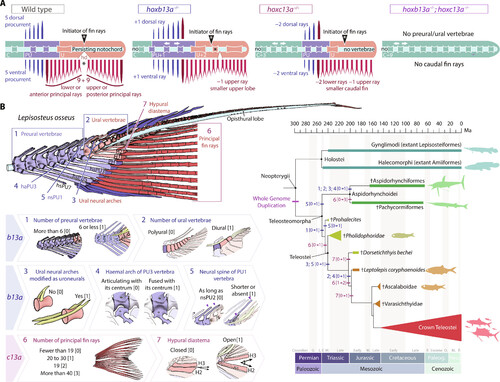Fig. 7
- ID
- ZDB-FIG-240329-7
- Publication
- Cumplido et al., 2024 - Hox genes control homocercal caudal fin development and evolution
- Other Figures
- All Figure Page
- Back to All Figure Page
|
b13a?/? and c13a?/? zebrafish mutants recapitulate the heterocercal-to-homocercal transition. (A) Linearized diagram illustrating the phenotypic differences in a single and double b13a?/? and c13a?/? mutants compared to a WT tail. White arrows indicate expanded body regions. ?Initiator of fin rays? indicates the position where caudal rays appear during ontogeny. The black asterisk represents the separation between upper and lower lobe caudal fin ray clusters. (B) Diagram of the caudal fin skeleton of the longnose gar Lepisosteus osseus, highlighting the main morphological characters reversed in b13a?/? and c13a?/? mutants (numbered from 1 to 7). States of the seven characters numbered from [0] to [3]. These characters are mapped on a simplified phylogeny of stem teleosts (44?46), with Holostei as an outgroup. Most characters experienced high homoplasy and underwent modifications during the evolution of basal teleosts in the Triassic during the heterocercal-to-homocercal transition. See Fig. 1 for anatomical terminology. |

